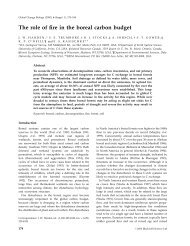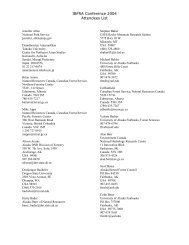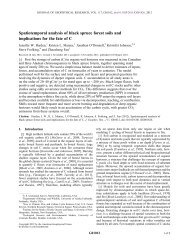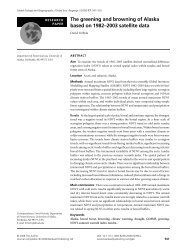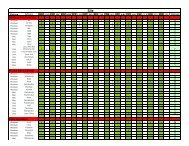Chapin, F.S., III, M.D. Robards, H.P. Huntington, J.F. Johnstone, S.F. ...
Chapin, F.S., III, M.D. Robards, H.P. Huntington, J.F. Johnstone, S.F. ...
Chapin, F.S., III, M.D. Robards, H.P. Huntington, J.F. Johnstone, S.F. ...
You also want an ePaper? Increase the reach of your titles
YUMPU automatically turns print PDFs into web optimized ePapers that Google loves.
F. S. <strong>Chapin</strong> et al., Directional Changes in Ecological Communities<br />
02/26/2007 07:26 AM<br />
a simple set of social-ecological predictions in which focus on short-term fire effects leads to fire<br />
suppression, which reduces long-term social benefit by reducing subsistence resources associated with early<br />
successional habitats and increasing the probability of large catastrophic fires.<br />
The use of marginal cost-benefit analysis in decision making can reinforce the focus on short-term costs<br />
and benefits if the cumulative effects over time are ignored or highly discounted. Sale of remote parcels of<br />
public land for recreational cabin sites in Alaska, for example, is evaluated based on economic gains to the<br />
state and its immediate impacts on recreational benefits without considering its incremental effect on number<br />
of human ignitions and fire regime. Similarly, rezoning a small area of forest for suburban development may<br />
have immediate social and economic benefits to local communities, but the cumulative effect of this policy<br />
is the creation of a wildland-urban interface where fire and wildlife management are major challenges. When<br />
analyses focus on fast variables that immediately affect people and ignore the slow variables, conditions arise<br />
that foster threshold ecological changes (hypotheses 1–3). Marginal analyses that place a higher value on<br />
long-term costs and benefits are less likely to exacerbate this risk (NRC 2005).<br />
Astute policy makers, scientists, and some activist groups focused on local sustainability are usually<br />
aware of many of the long-term effects of human actions on their local region. These effects include logging<br />
impacts on species requiring late-successional habitat, tillage effects on soil organic content and soil fertility,<br />
over-harvest of desirable fish and game species, pollution effects on ecosystem nitrogen retention and<br />
species diversity, effects of predator removal on prey abundance, and effects of pesticides on the evolution<br />
of resistance (Foley et al. 2005). Temporal disconnects can be minimized by identifying, quantifying, and<br />
assessing the long-term social costs of human impacts and developing policies that internalize these costs.<br />
Hypothesis 5. Human impacts that occur far from the site of decision making or that are geographically<br />
dispersed are often overlooked in policies that affect social-ecological systems. When people cause<br />
ecological impacts that do not directly affect them because the effects occur elsewhere or are geographically<br />
dispersed, overexploitation can become an attractive opportunity (Hardin 1968). Under these circumstances,<br />
larger-scale institutions, such as international conventions, have been used to prevent overexploitation (Dietz<br />
et al. 2003). For example, international institutions such as the Convention on the Conservation of Antarctic<br />
Marine Living Resources (CCAMLR 2000) are intended to reduce the spatial disconnect between economic<br />
pressures for overfishing and their ecological consequences. The effectiveness of these international<br />
conventions is often compromised, however, by self-interest and power politics among participating<br />
countries (Young 1989, 1994).<br />
High-latitude climate change is a prime example of spatial disconnects. Global warming is driven<br />
primarily by activities that are concentrated in nonarctic regions, including fossil fuel emissions of CO 2 , CH 4<br />
emissions from rice paddies and cattle, and N 2 O derived from nitrogen fertilizers in intensive agriculture.<br />
Feedbacks in the climate system (e.g., melting of sea ice) amplify this warming and its societal consequences<br />
at high latitudes. In Alaska, for example, warming causes hunting fatalities associated with travel on thin<br />
river or sea ice, a decline in availability of ice-dependent marine mammals (particularly pinnipeds) for<br />
file:///private/var/tmp/folders.501/TemporaryItems/com.apple.mail/compose/attach/<strong>Chapin</strong>2006AmNat.webarchive<br />
Page 11 of 21



